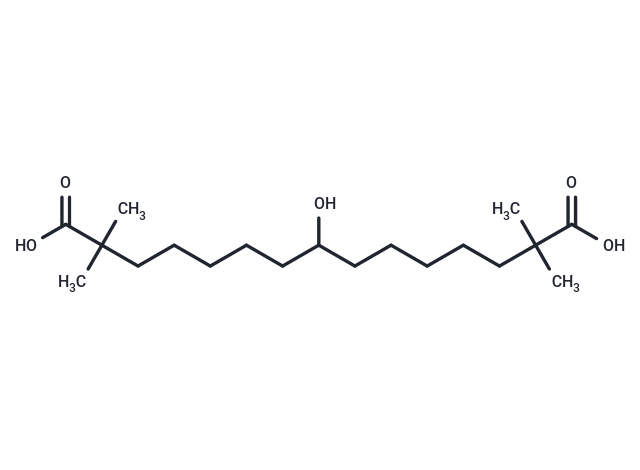Shopping Cart
- Remove All
 Your shopping cart is currently empty
Your shopping cart is currently empty

Bempedoic acid (ETC1002) is an orally available, once-daily LDL-C lowering small molecule designed to lower elevated levels of LDL-C and to avoid side effects associated with existing LDL-C lowering therapies. Bempedoic acid(ETC1002) is absorbed rapidly in the small intestine and enters the liver through cell surface receptors different from those transporters that selectively take up statins. Bempedoic acid(ETC1002) is a regulator of lipid and carbohydrate metabolism.

| Pack Size | Price | Availability | Quantity |
|---|---|---|---|
| 2 mg | $30 | In Stock | |
| 5 mg | $48 | In Stock | |
| 10 mg | $67 | In Stock | |
| 25 mg | $127 | In Stock | |
| 50 mg | $229 | In Stock | |
| 100 mg | $369 | In Stock | |
| 500 mg | $885 | In Stock | |
| 1 mL x 10 mM (in DMSO) | $50 | In Stock |
| Description | Bempedoic acid (ETC1002) is an orally available, once-daily LDL-C lowering small molecule designed to lower elevated levels of LDL-C and to avoid side effects associated with existing LDL-C lowering therapies. Bempedoic acid(ETC1002) is absorbed rapidly in the small intestine and enters the liver through cell surface receptors different from those transporters that selectively take up statins. Bempedoic acid(ETC1002) is a regulator of lipid and carbohydrate metabolism. |
| In vitro | ETC-1002 is an inactivated prodrug that is transformed into its activated form, an ACL inhibitor (activated state, ETC-1002-CoA), through endogenous liver ACS activity in vivo. It inhibits the migration of leukocytes to the peritoneal cavity of mice induced by sulfatide. Additionally, ETC-1002 restores the activity of lipid AMPK and reduces the phosphorylation of JNK in diet-induced obesity mouse models, leading to a decrease in the expression of the macrophage-specific marker 4F/80. |
| In vivo | The mechanism of action of TC-1002 primarily targets two liver enzymes: ATP-citrate lyase (ACL) and AMP-activated protein kinase (AMPK), inhibiting the synthesis of steroids and fatty acids while promoting the oxidation of mitochondrial long-chain fatty acids. ETC-1002 enhances AMPK phosphorylation levels, reduces the activity of MAPKs, and diminishes the production of pro-inflammatory cytokines and chemokines. |
| Kinase Assay | 7.5× compounds are added to a 96-well PolyPlate containing 60 μL of Buffer per well with substrates CoA (200 μM), ATP (400 μM), and [14C]citrate. Reaction is started with 4 μL (300 ng/well) ACL, and the plate is incubated at 37°C for 3 h. Th |
| Cell Research | Primary rat hepatocytes and differentiated human MDMs are treated with indicated concentrations of ETC-1002 for 12 h. Working solutions of ETC-1002 are prepared in serum-free RPMI 1640 containing 12 mM HEPES, 10,000 U/ml penicillin, and 100 μg/ml streptomycin. (Only for Reference) |
| Alias | ETC-1002, ETC1002, ETC 1002, ESP-55016 |
| Molecular Weight | 344.49 |
| Formula | C19H36O5 |
| Cas No. | 738606-46-7 |
| Smiles | CC(C)(CCCCCC(O)CCCCCC(C)(C)C(O)=O)C(O)=O |
| Relative Density. | 1.045 g/cm3 (Predicted) |
| Storage | Powder: -20°C for 3 years | In solvent: -80°C for 1 year | Shipping with blue ice. | |||||||||||||||||||||||||||||||||||
| Solubility Information | H2O: < 1 mg/mL (insoluble or slightly soluble) Ethanol: < 1 mg/mL (insoluble or slightly soluble) DMSO: 40 mg/mL (116.11 mM), Sonication is recommended. | |||||||||||||||||||||||||||||||||||
Solution Preparation Table | ||||||||||||||||||||||||||||||||||||
DMSO
| ||||||||||||||||||||||||||||||||||||

Copyright © 2015-2025 TargetMol Chemicals Inc. All Rights Reserved.